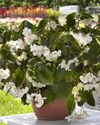Bees are classified according to common character traits.

Bees can be classified in many different ways. Their taxonomic classification uses shared characteristics that are indicative of relatedness between species, and this is best expressed as an evolutionary tree. However, nest architecture, sociality and floral biology can also be used to classify bees. According to taxonomic classification, any species can only belong to one group. Other classification systems cross taxonomic boundaries, and species groups will differ according to the classification criteria. Buzz pollinators, for example, will include some carpenters and some diggers, but neither all carpenter nor all diggers. The different classification systems have their uses.
Bees identification
South African bees are divided into six cosmopolitan families. Four of them (Melittidae, Colletidae, Andrenidae and Halictidae) are short-tongued bees. They may be able to extend their mouthparts a long way into tubular flowers, but then the entire mouthparts will be elongated and not just the tongue. Two families are long-tongued bees (Apidae, Megachilidae). The South African pollen-collecting bees can all quite easily be placed into families using The Bee Genera and Subgenera of sub-Saharan Africa (http:// www.abctaxa.be/volumes/vol-7-bees/). This booklet can also be used for identifying bee genera and sub-genera.
Bee nests
This story is from the November 2017 edition of The Gardener.
Start your 7-day Magzter GOLD free trial to access thousands of curated premium stories, and 8,500+ magazines and newspapers.
Already a subscriber ? Sign In
This story is from the November 2017 edition of The Gardener.
Start your 7-day Magzter GOLD free trial to access thousands of curated premium stories, and 8,500+ magazines and newspapers.
Already a subscriber? Sign In

Bordering on food aggression!
The economy, fires, drought, Russians, fuel prices, and politicians, dictated what we ate in my youth. The only exception was that Eskom worked...

Quarantining new koi fish
Give your new koi the best start

The beauty of BEGONIAS
For endless colour and a garden that looks vibrant throughout the seasons, these are your go-to choices.

Good BUGS
In a garden where creatures are free to prey on each other, the biological cycle plays out dramatically...

Heroines of HORTICULTURE
This year at the Chelsea Flower Show, women took centre stage in the Great Pavilion.

3 hasty shrubs
Most gardeners who plant new shrubs will tell you that they have a great impatience to see them grow fast and flower well. All plants need time to settle in before creating a performance, but some do it faster than others...

GOING VERTICAL
If you're not making use of the vertical space in your garden, you're missing out on a huge and essential part of not only design, but also space saving. Space is at a premium in all gardens, but particularly urban gardens where choice is limited. Going vertical is the best way to make use of 'empty' space and improve your design at the same time. It's a win-win.

Delights to DISCOVER
A horticultural masterpiece that just keeps on giving...

Purple Cone Flower
Echinacea purpurea is a flowering perennial herb that grows easily from seed and produces large pinkish purple daisy-like flowers with a reddish-brown central cone that attracts bees and other pollinators.

Divine combination
We trolled the streets, studying neighbourhood pavements and accessed gardens (with permission) to see what's growing and found red vygies and blue felicias in a late winter-colour-clinch with pretty rocks...